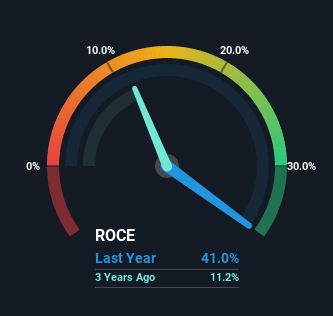Maral Overseas (NSE:MARALOVER) Is Investing Its Capital With Increasing Efficiency

If you're looking for a multi-bagger, there's a few things to keep an eye out for. Firstly, we'd want to identify a growing return on capital employed (ROCE) and then alongside that, an ever-increasing base of capital employed. Basically this means that a company has profitable initiatives that it can continue to reinvest in, which is a trait of a compounding machine. With that in mind, the ROCE of Maral Overseas (NSE:MARALOVER) looks great, so lets see what the trend can tell us.
Understanding Return On Capital Employed (ROCE)
For those who don't know, ROCE is a measure of a company's yearly pre-tax profit (its return), relative to the capital employed in the business. Analysts use this formula to calculate it for Maral Overseas:
Return on Capital Employed = Earnings Before Interest and Tax (EBIT) ÷ (Total Assets - Current Liabilities)
0.41 = ₹1.1b ÷ (₹5.9b - ₹3.1b) (Based on the trailing twelve months to March 2022).
Thus, Maral Overseas has an ROCE of 41%. In absolute terms that's a great return and it's even better than the Luxury industry average of 14%.
View our latest analysis for Maral Overseas

Historical performance is a great place to start when researching a stock so above you can see the gauge for Maral Overseas' ROCE against it's prior returns. If you want to delve into the historical earnings, revenue and cash flow of Maral Overseas, check out these free graphs here.
So How Is Maral Overseas' ROCE Trending?
The trends we've noticed at Maral Overseas are quite reassuring. The data shows that returns on capital have increased substantially over the last five years to 41%. The company is effectively making more money per dollar of capital used, and it's worth noting that the amount of capital has increased too, by 60%. So we're very much inspired by what we're seeing at Maral Overseas thanks to its ability to profitably reinvest capital.
On a separate but related note, it's important to know that Maral Overseas has a current liabilities to total assets ratio of 53%, which we'd consider pretty high. This effectively means that suppliers (or short-term creditors) are funding a large portion of the business, so just be aware that this can introduce some elements of risk. While it's not necessarily a bad thing, it can be beneficial if this ratio is lower.
The Key Takeaway
A company that is growing its returns on capital and can consistently reinvest in itself is a highly sought after trait, and that's what Maral Overseas has. Since the stock has returned a solid 54% to shareholders over the last five years, it's fair to say investors are beginning to recognize these changes. Therefore, we think it would be worth your time to check if these trends are going to continue.
One more thing: We've identified 3 warning signs with Maral Overseas (at least 1 which makes us a bit uncomfortable) , and understanding these would certainly be useful.
High returns are a key ingredient to strong performance, so check out our free list ofstocks earning high returns on equity with solid balance sheets.
New: Manage All Your Stock Portfolios in One Place
We've created the ultimate portfolio companion for stock investors, and it's free.
• Connect an unlimited number of Portfolios and see your total in one currency
• Be alerted to new Warning Signs or Risks via email or mobile
• Track the Fair Value of your stocks
Have feedback on this article? Concerned about the content? Get in touch with us directly. Alternatively, email editorial-team (at) simplywallst.com.
This article by Simply Wall St is general in nature. We provide commentary based on historical data and analyst forecasts only using an unbiased methodology and our articles are not intended to be financial advice. It does not constitute a recommendation to buy or sell any stock, and does not take account of your objectives, or your financial situation. We aim to bring you long-term focused analysis driven by fundamental data. Note that our analysis may not factor in the latest price-sensitive company announcements or qualitative material. Simply Wall St has no position in any stocks mentioned.
About NSEI:MARALOVER
Maral Overseas
Manufactures and sell yarns, fabrics, and garments in India, North America, Europe, Gulf and the Middle East, the Far East and South East Asia, Africa, and internationally.
Slight and slightly overvalued.
Similar Companies
Market Insights
Community Narratives



